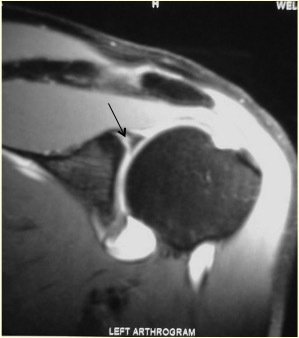How does a labral tear occur?
It commonly occurs in individuals who have suffered an injury to the shoulder such as falling on the outstretched arm, vehicular accidents or sporting injuries. It can also develop as a result of attrition in people who engage in overhead sports or activities.
How is a labral tear diagnosed?
This is a condition that results in symptoms of pain, “popping” or “clunking” of the shoulder. Occasionally the arm may feel “dead”. Pain may often only be experienced with overhead activities. Examination may show signs of pain with certain movements of the shoulder and signs of subtle restriction of movements. Pain may be reproduced on specific provocative tests. X-rays are often normal. Special imaging with an MRI scan is often necessary to obtain further information about the state of the labrum and the ligaments. In some instances an MR arthrogram (MRI scan after injection of contrast fluid in the joint) may be requested.
How is a labral tear treated?
In the early phase, pain may be controlled with activity modification and the use of pain relieving or anti-inflammatory medication.
Supervised physiotherapy: You may be advised to see a physiotherapist to start a regime of specific exercises to perform stretching to overcome any tightness in the joint, improve scapular positioning and strengthen the rotator cuff. Symptoms may improve with such treatment and may enable resumption of sporting activities.
Surgery: Surgery may be appropriate if symptoms fail to respond to nonoperative treatment measures. The operation performed will depend on the pathology identified on clinical and radiological assessment. It consists of an Arthroscopic repair where the tears in the labrum and ligaments are repaired with “keyhole” surgery. If there is stiffness in the joint then the tight areas of the capsule (or “sleeve”) may be released. For further information on surgical treatment, please refer to the section on “Surgery for labral tears”.
